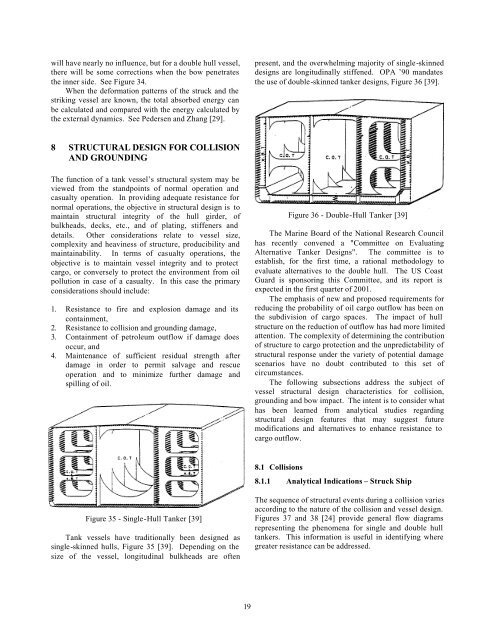Structural Design and Response in Collision and Grounding
Structural Design and Response in Collision and Grounding
Structural Design and Response in Collision and Grounding
You also want an ePaper? Increase the reach of your titles
YUMPU automatically turns print PDFs into web optimized ePapers that Google loves.
will have nearly no <strong>in</strong>fluence, but for a double hull vessel,there will be some corrections when the bow penetratesthe <strong>in</strong>ner side. See Figure 34.When the deformation patterns of the struck <strong>and</strong> thestrik<strong>in</strong>g vessel are known, the total absorbed energy canbe calculated <strong>and</strong> compared with the energy calculated bythe external dynamics. See Pedersen <strong>and</strong> Zhang [29].present, <strong>and</strong> the overwhelm<strong>in</strong>g majority of s<strong>in</strong>gle-sk<strong>in</strong>neddesigns are longitud<strong>in</strong>ally stiffened. OPA ’90 m<strong>and</strong>atesthe use of double-sk<strong>in</strong>ned tanker designs, Figure 36 [39].8 STRUCTURAL DESIGN FOR COLLISIONAND GROUNDINGThe function of a tank vessel’s structural system may beviewed from the st<strong>and</strong>po<strong>in</strong>ts of normal operation <strong>and</strong>casualty operation. In provid<strong>in</strong>g adequate resistance fornormal operations, the objective <strong>in</strong> structural design is toma<strong>in</strong>ta<strong>in</strong> structural <strong>in</strong>tegrity of the hull girder, ofbulkheads, decks, etc., <strong>and</strong> of plat<strong>in</strong>g, stiffeners <strong>and</strong>details. Other considerations relate to vessel size,complexity <strong>and</strong> heav<strong>in</strong>ess of structure, producibility <strong>and</strong>ma<strong>in</strong>ta<strong>in</strong>ability. In terms of casualty operations, theobjective is to ma<strong>in</strong>ta<strong>in</strong> vessel <strong>in</strong>tegrity <strong>and</strong> to protectcargo, or conversely to protect the environment from oilpollution <strong>in</strong> case of a casualty. In this case the primaryconsiderations should <strong>in</strong>clude:1. Resistance to fire <strong>and</strong> explosion damage <strong>and</strong> itsconta<strong>in</strong>ment,2. Resistance to collision <strong>and</strong> ground<strong>in</strong>g damage,3. Conta<strong>in</strong>ment of petroleum outflow if damage doesoccur, <strong>and</strong>4. Ma<strong>in</strong>tenance of sufficient residual strength afterdamage <strong>in</strong> order to permit salvage <strong>and</strong> rescueoperation <strong>and</strong> to m<strong>in</strong>imize further damage <strong>and</strong>spill<strong>in</strong>g of oil.Figure 36 - Double-Hull Tanker [39]The Mar<strong>in</strong>e Board of the National Research Councilhas recently convened a "Committee on Evaluat<strong>in</strong>gAlternative Tanker <strong>Design</strong>s". The committee is toestablish, for the first time, a rational methodology toevaluate alternatives to the double hull. The US CoastGuard is sponsor<strong>in</strong>g this Committee, <strong>and</strong> its report isexpected <strong>in</strong> the first quarter of 2001.The emphasis of new <strong>and</strong> proposed requirements forreduc<strong>in</strong>g the probability of oil cargo outflow has been onthe subdivision of cargo spaces. The impact of hullstructure on the reduction of outflow has had more limitedattention. The complexity of determ<strong>in</strong><strong>in</strong>g the contributionof structure to cargo protection <strong>and</strong> the unpredictability ofstructural response under the variety of potential damagescenarios have no doubt contributed to this set ofcircumstances.The follow<strong>in</strong>g subsections address the subject ofvessel structural design characteristics for collision,ground<strong>in</strong>g <strong>and</strong> bow impact. The <strong>in</strong>tent is to consider whathas been learned from analytical studies regard<strong>in</strong>gstructural design features that may suggest futuremodifications <strong>and</strong> alternatives to enhance resistance tocargo outflow.8.1 <strong>Collision</strong>s8.1.1 Analytical Indications – Struck ShipFigure 35 - S<strong>in</strong>gle-Hull Tanker [39]Tank vessels have traditionally been designed ass<strong>in</strong>gle-sk<strong>in</strong>ned hulls, Figure 35 [39]. Depend<strong>in</strong>g on thesize of the vessel, longitud<strong>in</strong>al bulkheads are oftenThe sequence of structural events dur<strong>in</strong>g a collision variesaccord<strong>in</strong>g to the nature of the collision <strong>and</strong> vessel design.Figures 37 <strong>and</strong> 38 [24] provide general flow diagramsrepresent<strong>in</strong>g the phenomena for s<strong>in</strong>gle <strong>and</strong> double hulltankers. This <strong>in</strong>formation is useful <strong>in</strong> identify<strong>in</strong>g wheregreater resistance can be addressed.19
















